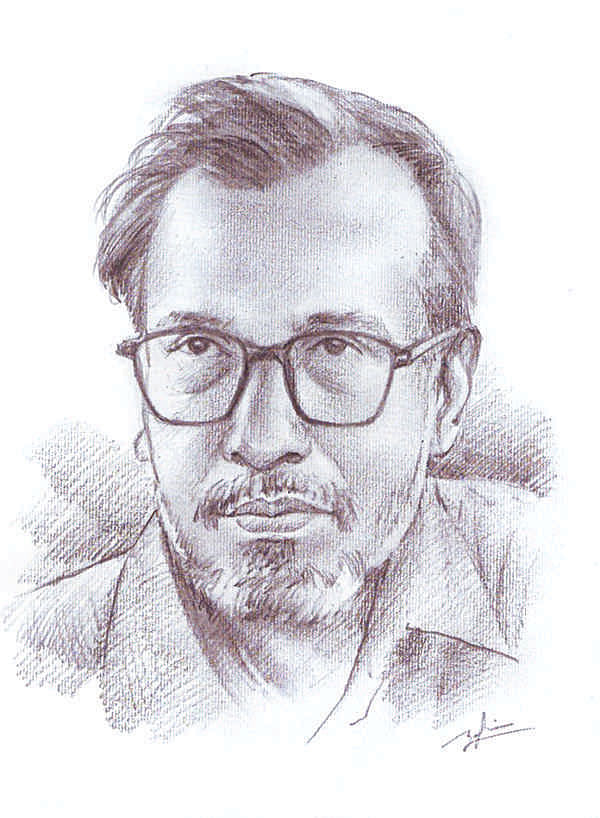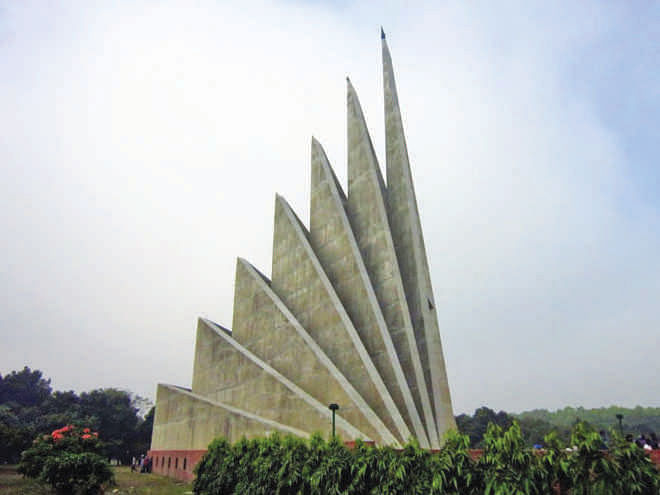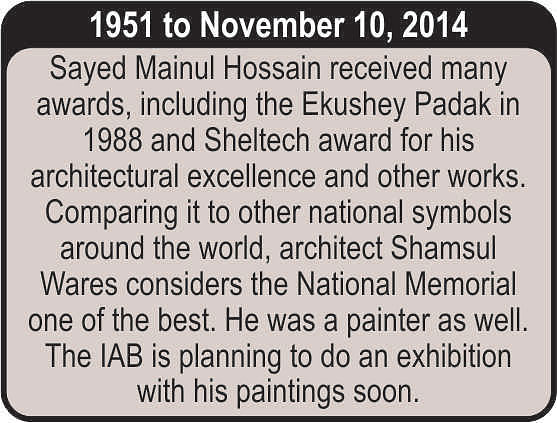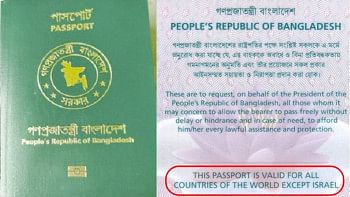A Belated Tribute

It is very hard to find a single person in the country who isn't familiar with the brilliant architecture of the National Memorial. The mausoleum, composed of seven triangles, has been placed in text books, coins, posters, used as government symbols and in so many places that there is no way you can ignore it. But how many of us really know the man behind this amazing design? How many text books contain the name of the architect of the memorial that honours the country's most revered heroes?
As days stretch into weeks and weeks into months, memory fades. We consciously or unconsciously forget the contributions of great men, and gradually remove them from our memory. The way the country and its people treated architect Syed Mainul Hossain in his lifetime, shows how ignorant we are about our national pride.
Year after year his signature work drew seas of people, and it united and shaped our symbol of unity. However, he was neglected and ignored throughout his life. Architect Md Dill Shad Hossen, former president of the Institute of Architects Bangladesh (IAB), says in one of his writings, “I represented the National Memorial in different international conferences on architecture but was negligent towards the man behind it. As a former president of the IAB, did I fulfil my duty towards a fellow architect? ... I seek forgiveness from his family."
In 1978, the government formed a committee chaired by celebrated architect Muzharul Islam to hold a competition to choose a design that would uphold the spirit of our independence. It was a momentous decision for the nation. The architecture had to represent the struggle for liberty. So, a proposal for the architecture was placed before Mazharul Islam but he rejected it and emphasised the need of a competition that would enable young architects to come up with new ideas. A member of that committee, renowned architect Shamsul Wares, shares his experience, “The architecture department of Bangladesh University of Engineering and Technology (BUET) was formed in the early sixties and only a few batches had graduated. But still we announced a competition for all. We thought the idea was important not experience or age."
Mainul along with other architects submitted their proposals but the committee was not pleased with the submissions. So there was a second call for the competition.

Just a day before the submission date, Mainul went to his university friend and roommate, architect Badrul Haider's place with the individual components of his design. Badrul says, “And when he assembled them on a table, I was sure that none of my designs were anywhere near his.” During the submission at the Architecture Department of the PWB Bhaban, all the other competitors were certain that no one's work would be able to stand against Mainul's.
“The first round disappointed us. We were looking for a unique design that represented the soul of our national identity,” Wares says, adding that Mainul's work stunned the selection committee. It had all the components that the committee was looking for.

The design composed of seven geometric triangles varying in size, created an optical illusion. If we see it from the front, we see curved lines meeting at the top. But interestingly the triangles are not curved shape but the architect designed them in a way to create an illusion of curved lines. From its two different sides, the triangles of the structure give a firm gravitational expression of strength and togetherness. “The structure looks like large paleolithic stones creating a monolithic togetherness of our struggle for emancipation and independence. It is unique and you cannot find an idea that can rival this around the world. On that we selected his design,” Wares says.
The design that was selected by the jury had eight triangles. But when its construction began, Mainul changed his design. He was not fully satisfied with it and worked on it once again. His logic was that the eight triangles didn't fit the proportion of the landscape given to erect the structure. At that time the idea of seven remarkable movements popped up in his mind and he changed it accordingly.
The memorial's main mausoleum, the 150-feet tall seven triangles, symbolises the valour and sacrifice of those who fought, the seven remarkable movements that changed the course of our history from 1952 to 71. It also represents the seven Birshreshthas who fought for an independent land and met death for the sake of their nation. He described it in an interview with journalist Moshiul Alam as, “Something rising from beneath the ground due to some great pressure.”
However, the main structure of the National Memorial was built along with the artificial lake and other facilities in 1982. Mainul was the designer of the main structure and the landscape was designed by architect Abdur Rashid of PWB. For some unknown reason, during the inauguration of the structure on December 16, 1982, Mainul was not invited. Amidst thousands of visitor, he was able to see his creation only after the VIP guests departed the memorial.
Following his splendid design, he gradually began to lose his mind. An unknown fear of death and his complains against architects stealing his ideas became a part of his routine life. He withdrew from society and started to live in a house swathed in darkness in Shantinagar. From the interview with Moshiul Alam, we come to know that he had trouble whenever there was any light in the room and always closed the curtains tightly, so that no light could filter in.
In his student life, Mainul was a different person altogether, always speaking with friends with wit and humour. His friend Badrul says that he was always thinking of new ideas. Sometimes teachers didn't like that about him, resulting in poor grades but he never stopped his pursuit of finding a new meaning of architecture.
Mainul and Badrul worked together in Shahidullah & Associates. Mainul sat just behind Badrul and since they were not permitted to talk, Mainul used to throw small notes at him. Badrul still has them. One of it reads, “In my childhood I read a comic adaptation of Oliver Twist. Often, the last portion of the story appears in my dreams-- a beautiful home."
Dr Abu Sayeed M Ahmed, President of the IAB, admits that it is their fault that they neglected him in his lifetime, “It is truly unfortunate that we forgot about his condition during his lifetime. We cannot avoid our irresponsibility.” The IAB is planning to arrange a painting exhibition, short bio (film) and a seminar to honour this legend.
When somebody dies we shower him with accolades but we don't really care about that person when s/he is alive. His close friend Badrul believes that this practice should be changed, as he says, “We are all responsible for his untimely withdrawal from architecture and death. We cannot deny it.”

 For all latest news, follow The Daily Star's Google News channel.
For all latest news, follow The Daily Star's Google News channel. 



Comments